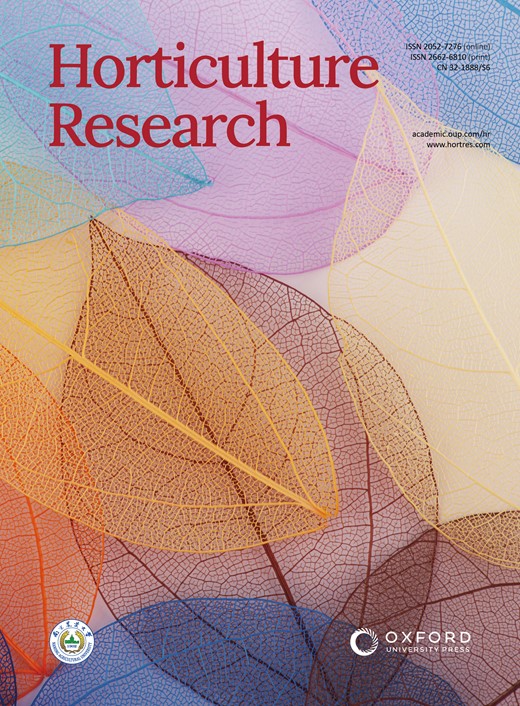利用全基因组关联分析推断高丛蓝莓果实质地的遗传基础
IF 8.7
1区 农林科学
Q1 Agricultural and Biological Sciences
引用次数: 0
摘要
蓝莓(Vaccinium spp.)是一种以富含生物活性和抗氧化化合物而闻名的特种作物,其全球产量和消费量在过去十年中增长了一倍多。为了保持这一势头,植物育种者已开始利用定量遗传学和分子育种来指导他们的决策,并选择出能改善果实品质的新栽培品种。在本研究中,我们通过调查北方(NHB)和南方(SHB)高丛蓝莓(两种主要栽培蓝莓)的大型育种群体,充分利用了我们对果实质地和化学成分遗传基础的推断。在对俄勒冈州立大学种植的 1065 个 NHB 基因型和佛罗里达大学培育的 992 个 SHB 基因型的 20 个质地相关性状进行多年评估后,我们的贡献包括(i) 我们提请注意 NHB 和 SHB 材料之间的差异,并表明这两种蓝莓类型均可通过质地性状加以区分;(ii) 我们计算了遗传参数,并阐明了重要质地属性的遗传结构,表明大多数性状具有复杂性,遗传率为中低水平;(iii) 通过分子育种,我们强调可以在不同种群间进行预测;最后 (iv) 通过基因组关联分析,我们确定了一些含有潜在质地候选基因的基因组区域,可用于进一步的验证研究。总之,本文所使用的方法和途径可以指导未来的育种工作,最大限度地改善蓝莓的质地。本文章由计算机程序翻译,如有差异,请以英文原文为准。
Inference of the genetic basis of fruit texture in highbush blueberries using genome-wide association analyses
The global production and consumption of blueberry (Vaccinium spp.), a specialty crop known for its abundant bioactive and antioxidant compounds, has more than doubled over the last decade. To hold this momentum, plant breeders have begun to use quantitative genetics and molecular breeding to guide their decisions and select new cultivars that are improved for fruit quality. In this study, we leveraged our inferences on the genetic basis of fruit texture and chemical components by surveying large breeding populations from northern (NHB) and southern (SHB) highbush blueberries, the two dominant cultivated blueberries. After evaluating 1065 NHB genotypes planted at the Oregon State University, and 992 SHB genotypes maintained at the University of Florida for 20 texture-related traits, evaluated over multiple years, our contributions consist of: (i) We drew attention to differences between NHB and SHB materials and showed that both blueberry types can be differentiated using texture traits; (ii) We computed genetic parameters and shed light on the genetic architecture of important texture attributes, indicating that most traits had a complex nature with low to moderate heritability; (iii) using molecular breeding, we emphasized that prediction could be performed across populations; and finally (iv) the genomic-association analyses pinpointed some genomic regions harboring potential candidate genes for texture that could be used for further validation studies. Altogether, the methods and approaches used here can guide future breeding efforts focused on maximizing texture improvements in blueberries.
求助全文
通过发布文献求助,成功后即可免费获取论文全文。
去求助
来源期刊

Horticulture Research
Biochemistry, Genetics and Molecular Biology-Biochemistry
CiteScore
11.20
自引率
6.90%
发文量
367
审稿时长
20 weeks
期刊介绍:
Horticulture Research, an open access journal affiliated with Nanjing Agricultural University, has achieved the prestigious ranking of number one in the Horticulture category of the Journal Citation Reports ™ from Clarivate, 2022. As a leading publication in the field, the journal is dedicated to disseminating original research articles, comprehensive reviews, insightful perspectives, thought-provoking comments, and valuable correspondence articles and letters to the editor. Its scope encompasses all vital aspects of horticultural plants and disciplines, such as biotechnology, breeding, cellular and molecular biology, evolution, genetics, inter-species interactions, physiology, and the origination and domestication of crops.
 求助内容:
求助内容: 应助结果提醒方式:
应助结果提醒方式:


